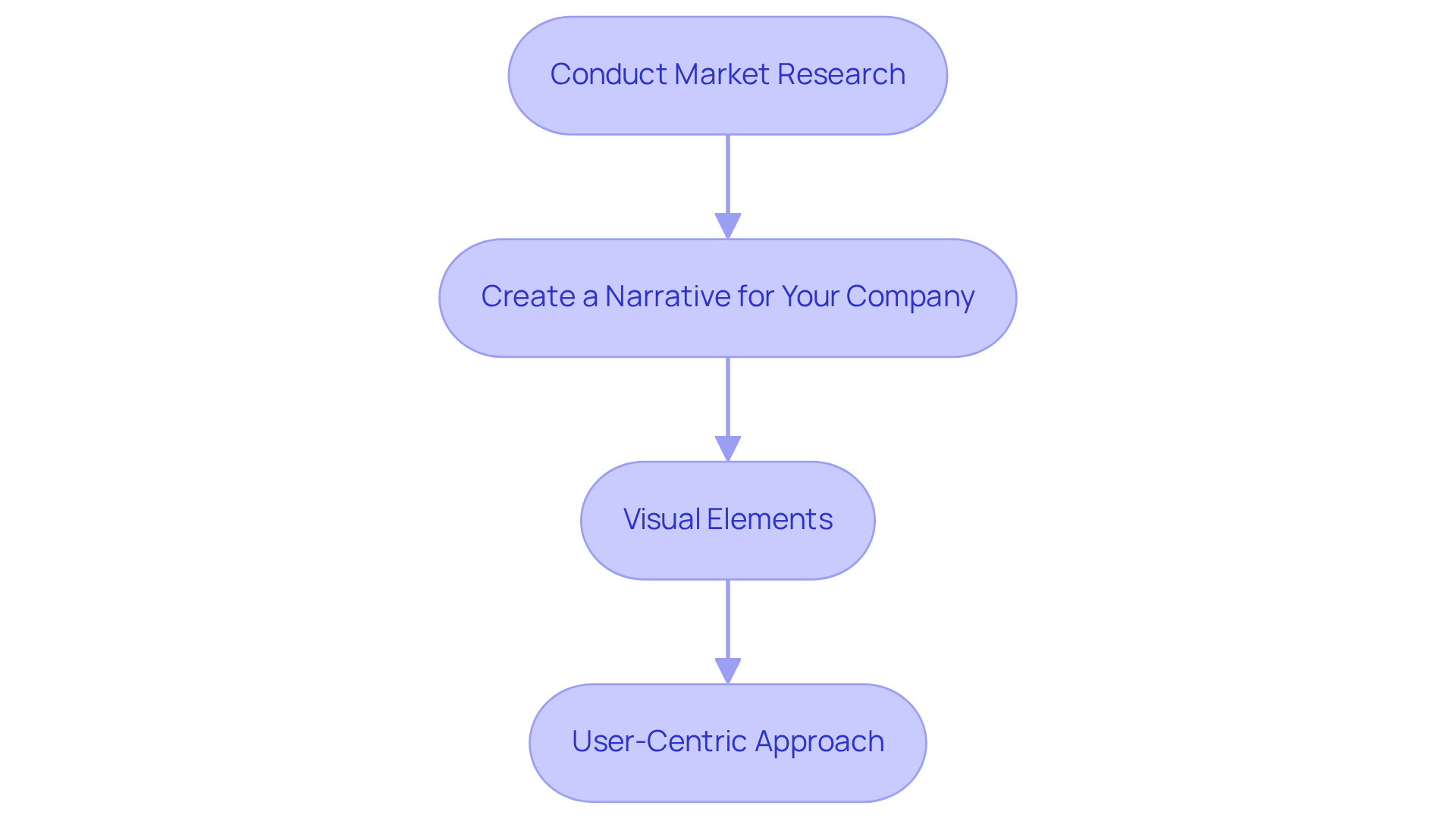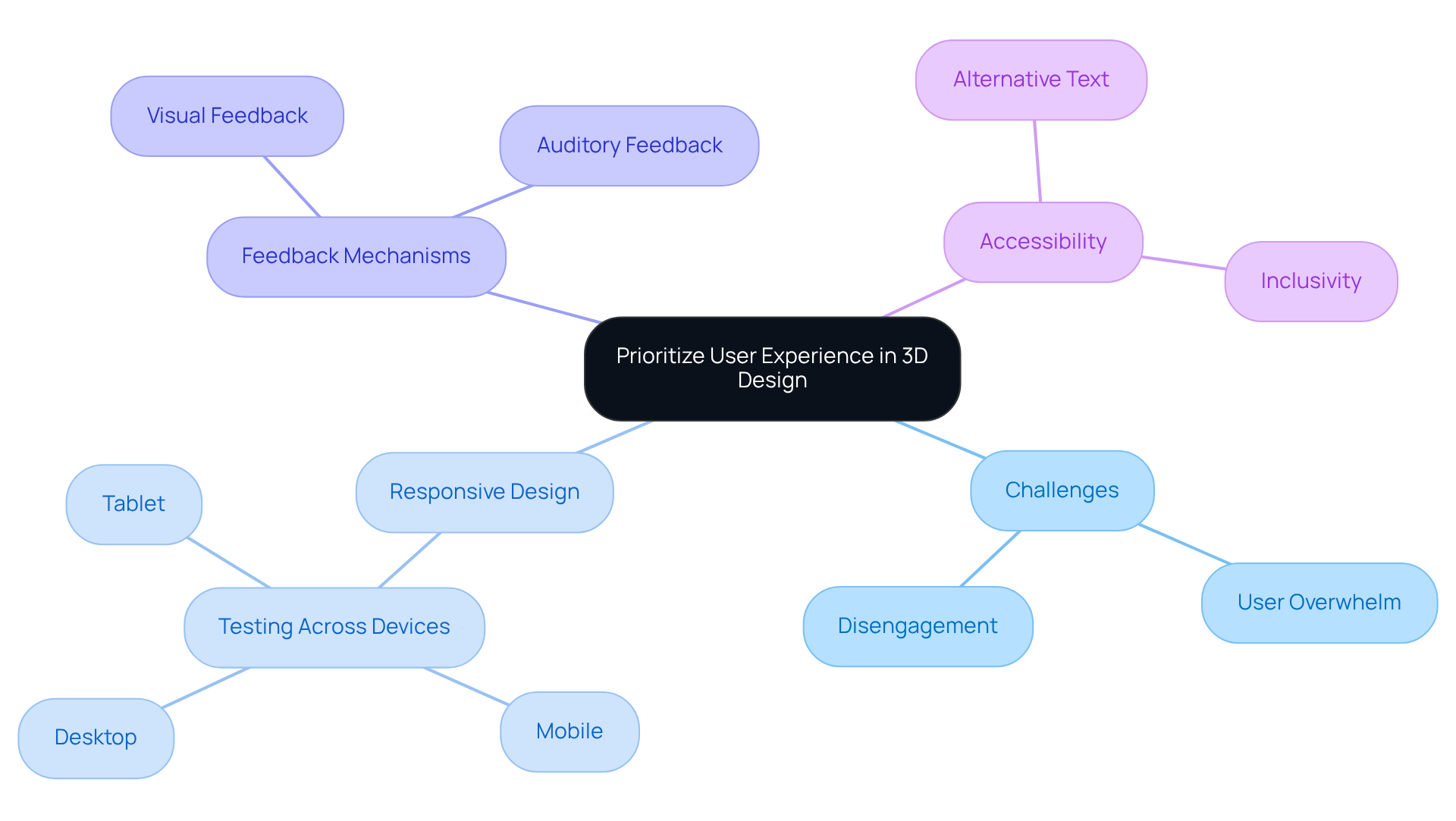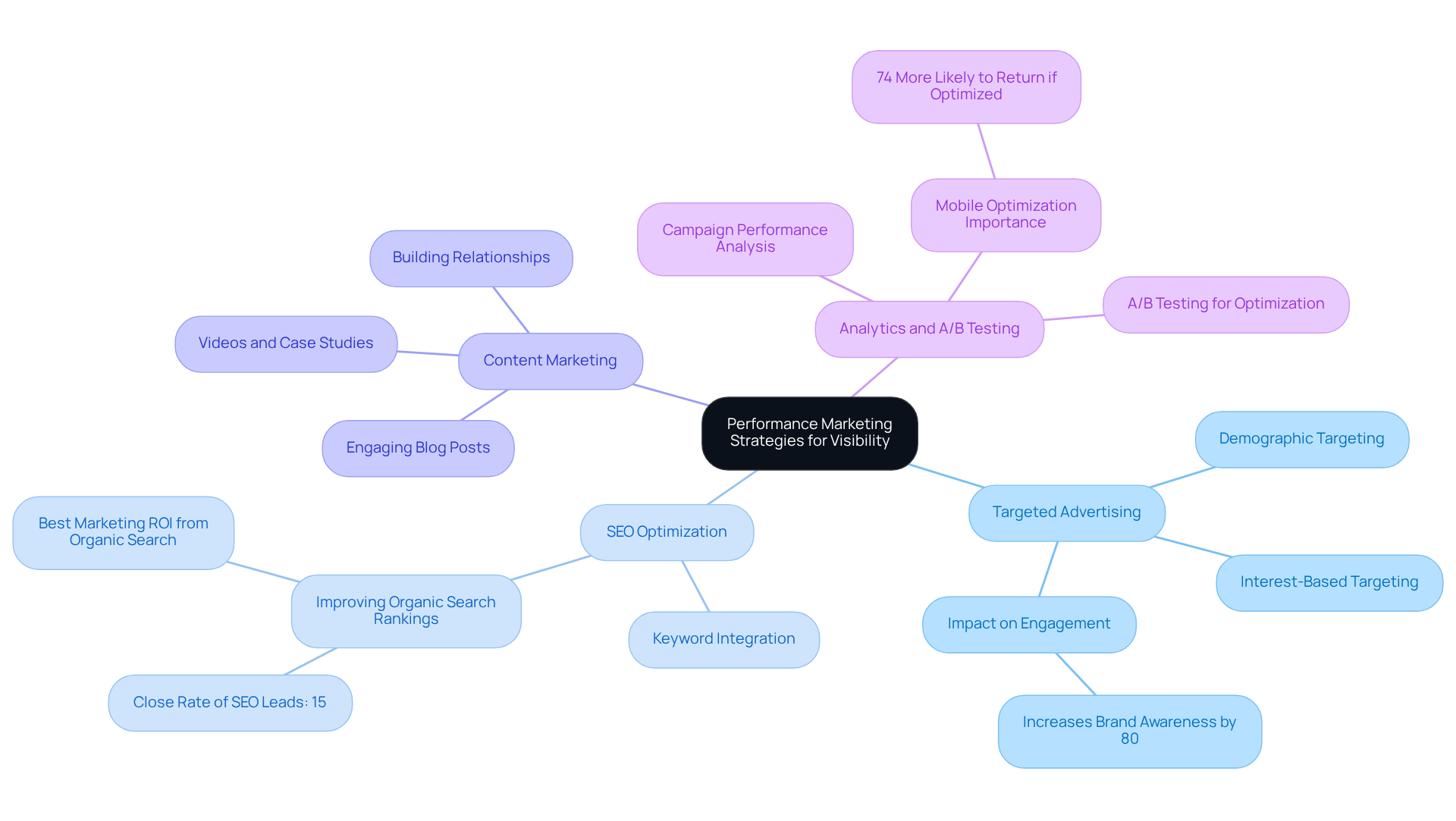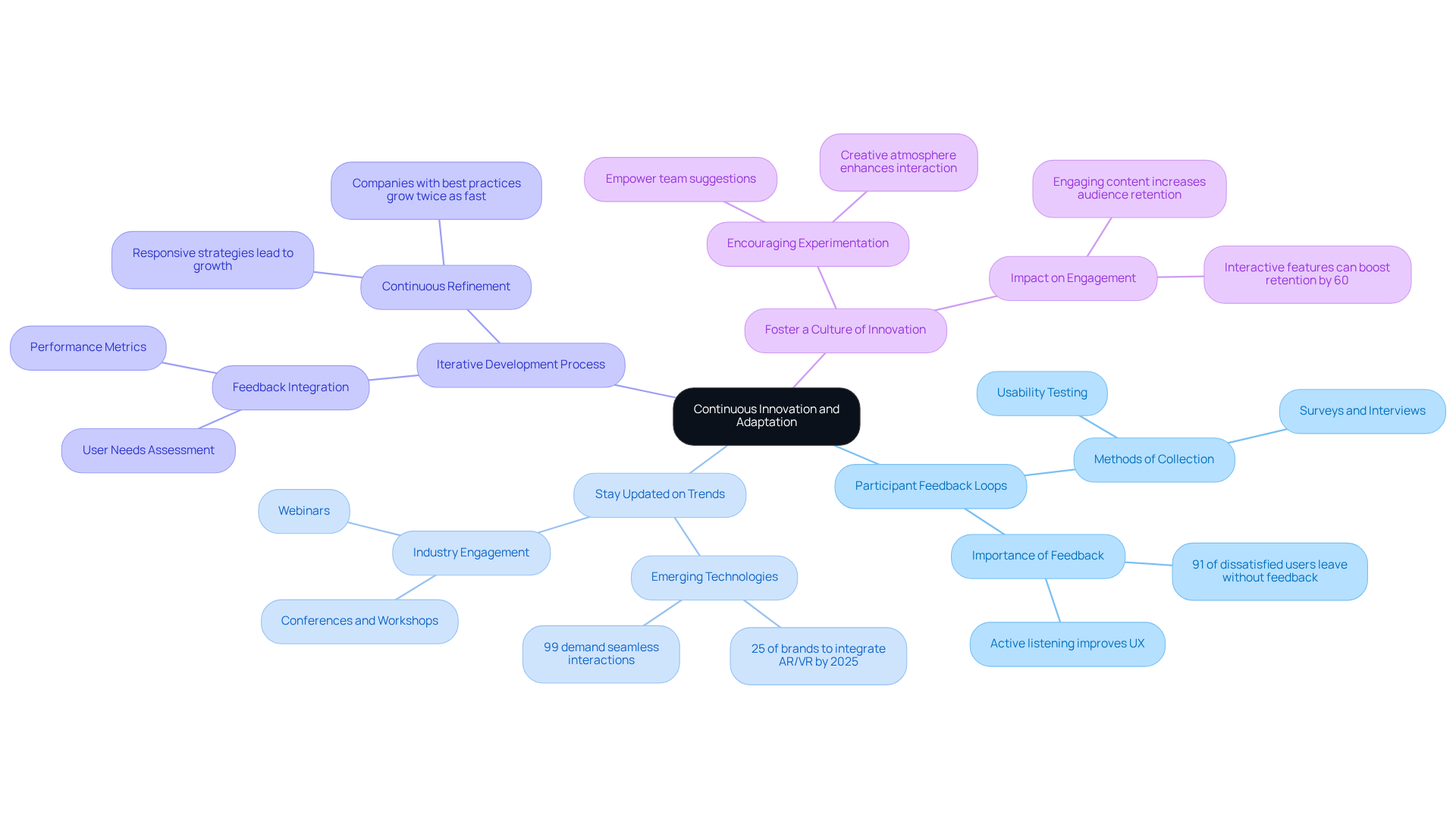Overview
Creating effective 3D websites in tech startups can feel overwhelming, especially when it comes to defining your brand identity and ensuring a seamless user experience. Many founders grapple with these challenges, often feeling lost in the competitive digital landscape. It's important to recognize that these struggles are common and can lead to frustration and uncertainty about your startup's potential.
However, there is hope. By focusing on four key practices—defining brand identity, prioritizing user experience, implementing performance marketing strategies, and embracing continuous innovation—you can pave the way for success. These practices are not just strategies; they are lifelines that can enhance engagement, visibility, and adaptability. Imagine conducting thorough market research to truly understand your audience, or adopting a user-centric design that resonates with their needs. Picture implementing targeted advertising that speaks directly to potential customers, and establishing feedback loops that allow for continuous improvement.
These strategies collectively create a nurturing environment where your startup can thrive. It's about more than just building a website; it's about fostering a community and connecting with your users on a deeper level. As you navigate this journey, remember that you're not alone. Many entrepreneurs have faced similar hurdles, and by sharing experiences and insights, we can support one another in this endeavor.
In conclusion, embracing these practices will not only enhance your website's effectiveness but also create a meaningful connection with your audience. Together, we can transform challenges into opportunities for growth and innovation.
Introduction
Crafting a compelling 3D website can feel overwhelming, especially for tech startups eager to establish their unique presence in a crowded market. As you navigate the intricate web of brand identity, user experience, and performance marketing, it’s natural to feel the pressure of not only attracting your audience but also keeping their attention. This article explores four essential practices designed to empower you in creating effective 3D websites. These strategies can enhance engagement and nurture deeper connections with your users.
How might you leverage these insights to transform your online presence and achieve success in our ever-evolving digital landscape? Together, we can explore the possibilities.
Define Your Brand Identity for 3D Experiences
To effectively define your identity for 3D websites, it’s important to clearly articulate your core values and mission. Many tech startup founders face the challenge of standing out in a crowded market, and understanding how to connect with your audience is key. Here are some nurturing steps to guide you:
- Conduct Market Research: Begin by gaining insights into your target audience and competitors. It’s crucial to understand what resonates with your audience and how competitors position themselves. A study by Adobe reveals that British participants are more inclined to buy from companies they trust. This highlights the importance of building a solid reputation from the outset, fostering a sense of security for your potential customers.
- Create a Narrative for Your Company: Develop a compelling story that encapsulates your company’s journey, values, and vision. This narrative should serve as a guiding framework for all design decisions, including the integration of 3D websites. As branding specialist Simon Mainwaring emphasizes, an identity is defined by its purpose and how it personally connects with customers. A strong narrative can create a sense of belonging and trust, making your brand more relatable.
- Visual Elements: Choose colors, typography, and imagery that . Consistency across all 3D websites strengthens identity recognition and fosters trust. Walter Landor wisely noted, "a label is a promise." Maintaining consistency in visual elements is essential for creating a positive image in consumers’ minds, enhancing both product value and sentiment.
- User-Centric Approach: Customize your identity to satisfy the needs and preferences of your users. This ensures that your 3D interactions are not only visually appealing but also relevant and engaging. Ashley Friedlein highlights the importance of understanding customer feelings through social media monitoring tools, which can effectively assist in tailoring your identity.
By following these steps, you can nurture a strong brand identity that enhances your interactions on 3D websites and fosters deeper connections with your audience. Remember, you’re not alone in this journey; many founders share similar experiences and challenges, and together we can build something meaningful.

Prioritize User Experience in 3D Design
To prioritize in your 3D design, it's essential to acknowledge the challenges that can arise. Many individuals feel overwhelmed by complex 3D elements, which can lead to frustration and disengagement. It's crucial to create an environment where navigation feels intuitive, allowing users to easily understand how to interact with the 3D content.
Responsive design plays a vital role here. Imagine the relief of knowing that your 3D interactions are optimized for various devices and screen sizes. Testing on mobile, tablet, and desktop ensures a seamless experience across platforms, making your users feel valued and understood.
Incorporating feedback mechanisms can significantly enhance user engagement. Visual and auditory feedback, such as animations that react to participant actions, can transform the experience, making it more interactive and satisfying. This connection fosters a sense of involvement and enjoyment.
Moreover, accessibility considerations are paramount. By designing your 3D interactions with inclusivity in mind, such as providing alternative text for 3D models, you ensure that everyone can participate fully, including individuals with disabilities. This thoughtful approach not only enhances usability but also reflects a commitment to community.
By concentrating on these elements, tech startups can develop 3D websites that engage users and offer a seamless, pleasurable experience. Remember, your efforts in prioritizing user experience will resonate deeply with your audience, fostering a sense of connection and trust.

Implement Performance Marketing Strategies for Visibility
To effectively navigate the challenges of performance marketing for your 3D websites, it's essential to consider strategies that truly resonate with your audience's needs. Many startup founders struggle to gain visibility and attract customers, which can be disheartening. However, there are compassionate approaches that can help you overcome these hurdles.
- Targeted Advertising: Imagine crafting ad campaigns that speak directly to the hearts of your specific audience. By leveraging platforms like Google Ads and social media, you can utilize demographic and interest-based targeting to ensure your ads reach those who genuinely care about your offerings. This targeted approach can significantly boost engagement and conversion rates, with digital ads increasing brand awareness by 80%. Your message deserves to be seen by potential customers who will appreciate it.
- SEO Optimization: Enhancing your website's visibility is crucial, and optimizing for search engines is a powerful way to achieve this. By incorporating relevant keywords related to 3D design and your industry into your meta tags, descriptions, and content for 3D websites, you can improve your organic search rankings. This will make it easier for people to discover your unique offerings. Remember, SEO leads have a close rate of nearly 15%, and 49% of businesses find that organic search provides the best marketing ROI.
- Content Marketing: Developing engaging content that showcases your 3D websites can create meaningful connections with your audience. Consider sharing blog posts, videos, and case studies that highlight the benefits of your designs and how they meet the needs of individuals. Effective content marketing not only drives traffic but also fosters deeper relationships with your audience, allowing them to see the value you provide.
- Analytics and A/B Testing: Regularly analyzing your marketing campaigns is vital to identify what strategies resonate with your audience. Utilize to explore various ad creatives, landing pages, and calls to action, enabling you to enhance performance based on real data. It's also important to avoid common pitfalls, such as neglecting mobile optimization; 74% of people are more likely to return to a website if it’s optimized for mobile.
By embracing these strategies, tech startups can significantly enhance their visibility and draw more visitors to their 3D websites. For instance, consider the success of WebFX, which has generated over 24 million leads for clients, demonstrating the effectiveness of these compassionate strategies in real-world applications. Remember, you are not alone in this journey, and with the right support, your startup can thrive.

Embrace Continuous Innovation and Adaptation
To foster and adaptation in your 3D websites, it’s essential to acknowledge the challenges you face. Many tech startup founders grapple with keeping up with rapid advancements and user expectations in this dynamic landscape. This can lead to frustration and a sense of being overwhelmed. However, by embracing specific practices, you can transform these challenges into opportunities for growth and connection.
- Participant Feedback Loops: Regularly collecting participant input on their interactions with your 3D elements can be incredibly beneficial. By utilizing surveys, interviews, and usability testing, you can gather valuable insights that guide future enhancements. Research indicates that 91% of dissatisfied individuals will depart without providing feedback, underscoring the importance of proactive engagement. As Annemarie Bufe wisely states, "You have to actively listen to customers to understand how they feel and make changes to improve the user experience (UX)."
- Stay Updated on Trends: It’s crucial to stay informed about emerging trends in 3D design and technology. Participating in industry conferences, webinars, and workshops can unveil new tools and techniques that elevate your offerings. Notably, 25% of major brands are expected to integrate augmented reality (AR) or virtual reality (VR) interactivity into their websites by 2025, highlighting the growing significance of these technologies. Additionally, 99% of individuals demand seamless interactions across devices and platforms, reinforcing the need to remain updated on trends that enhance engagement.
- Iterative Development Process: Embracing an iterative development approach allows for continuous refinement of your 3D experiences based on feedback and performance metrics. This method ensures your creations evolve to meet user needs effectively. Companies that adopt leading creative practices expand twice as quickly as the industry benchmark growth rate, emphasizing the importance of a responsive strategy. As Annemarie Bufe observes, "Companies that adopt superior practices grow twice as fast as the industry benchmark growth rate."
- Foster a Culture of Innovation: Cultivating an environment that encourages experimentation with new ideas and technologies is vital. Empower your team to suggest and evaluate innovative solutions, as a creative atmosphere can lead to transformative improvements in client interaction. Engaging content and interactive web design can significantly enhance audience retention, with studies indicating that interactive features can elevate retention by as much as 60%. Jon Evans highlights, "When you aim to enhance your conversions, the key is straightforward: concentrate on the client's interaction."
By adopting these nurturing practices, tech startups can ensure their 3D websites remain at the forefront of innovation while aligning with user expectations. Remember, you are not alone in this journey; together, we can create impactful and engaging experiences that resonate with your audience.

Conclusion
In the journey of creating impactful 3D websites, tech startups often encounter challenges that can feel overwhelming. It’s essential to recognize that these hurdles not only affect brand identity but also influence user experience and visibility. By establishing a strong brand narrative and prioritizing user-centric design, startups can begin to forge deeper connections with their audiences. Implementing performance marketing strategies and embracing continuous innovation are vital steps in nurturing a successful online presence.
Conducting thorough market research is crucial for understanding target audiences and competitors. Crafting compelling narratives that reflect core values and ensuring consistent visual elements across platforms can be transformative. Moreover, prioritizing user experience through intuitive navigation, responsive design, and accessibility considerations significantly enhances engagement. Strategies like targeted advertising, SEO optimization, and content marketing amplify visibility, while a commitment to continuous innovation allows startups to remain agile and responsive to the ever-evolving expectations of their users.
In this rapidly changing digital landscape, it’s not just about adopting these practices; it’s about fostering a culture of ongoing improvement and adaptation. By actively seeking feedback from users and nurturing a spirit of innovation, startups can create 3D experiences that truly resonate with their audiences. Embracing these principles not only enhances brand recognition and trust but also lays a solid foundation for long-term success in the tech industry. Together, we can navigate this journey and build a brighter future for your startup.
Frequently Asked Questions
How can I define my brand identity for 3D experiences?
To define your brand identity for 3D experiences, clearly articulate your core values and mission, conduct market research to understand your audience and competitors, create a compelling narrative for your company, choose consistent visual elements, and adopt a user-centric approach.
Why is market research important for defining brand identity?
Market research is crucial as it provides insights into your target audience and competitors. Understanding what resonates with your audience helps in building a solid reputation and fostering trust, which can lead to increased customer loyalty.
What role does storytelling play in brand identity?
Developing a compelling narrative encapsulates your company’s journey, values, and vision. This story serves as a guiding framework for design decisions and helps create a sense of belonging and trust with customers.
How should visual elements be chosen for 3D websites?
Visual elements such as colors, typography, and imagery should represent your company’s personality. Consistency across all 3D websites enhances identity recognition and builds trust, which is essential for creating a positive brand image.
What is a user-centric approach in defining brand identity?
A user-centric approach involves customizing your identity to meet the needs and preferences of your users. This ensures that your 3D interactions are visually appealing, relevant, and engaging for your audience.
How can social media monitoring assist in tailoring brand identity?
Social media monitoring tools can help you understand customer feelings and preferences, allowing you to adjust your brand identity to better connect with your audience and enhance engagement.




